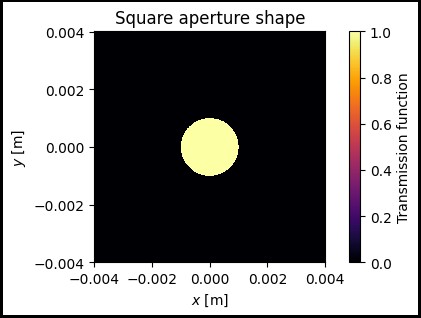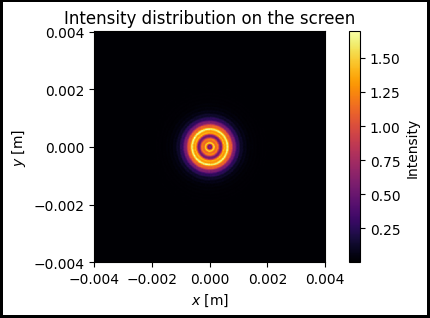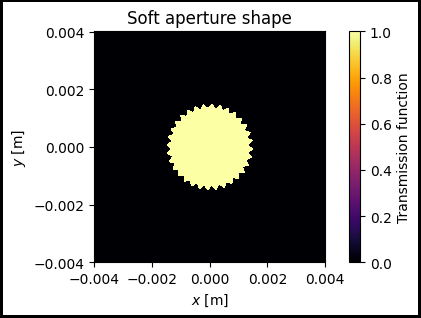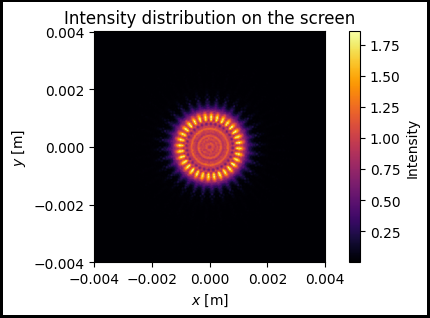[1]:
import torch
import matplotlib.pyplot as plt
from svetlanna import elements
from svetlanna import SimulationParameters
from svetlanna import wavefront as w
from svetlanna.units import ureg
Diffraction on the apertures
We will calculate the diffraction of the plane wave on the different apertures using classes from svetlanna.elements
Creating numerical mesh with using SimulationParameters class
[14]:
# screen size
lx = 8 * ureg.mm
ly = 8 * ureg.mm
# distance between the screen and the aperture, mm
z = 220 * ureg.mm
# wavelength, mm
wavelength = 1064 * ureg.nm
# number of nodes
Nx = 1024
Ny = 1024
# creating SimulationParameters exemplar
sim_params = SimulationParameters({
'W': torch.linspace(-lx / 2, lx / 2, Nx),
'H': torch.linspace(-ly / 2, ly / 2, Ny),
'wavelength': wavelength,
})
[15]:
# return 2d-tensors of x and y coordinates
x_grid, y_grid = sim_params.meshgrid(x_axis='W', y_axis='H')
Creating a plane wave using svetlanna.wavefront.plane_wave
Let’s create a plane wave that will fall on the aperture:
[16]:
# create plane wave
incident_field = w.Wavefront.plane_wave(
simulation_parameters=sim_params,
distance=0 * ureg.cm,
wave_direction=[0, 0, 1]
)
Creating round aperture using svetlanna.elements.RoundAperture
[17]:
radius = 1 * ureg.mm
round_aperture = elements.RoundAperture(
simulation_parameters=sim_params,
radius=radius,
)
Let’s see the shape of the aperture using .get_transmission_function() class method:
[18]:
aperture_transmission_function = round_aperture.get_transmission_function()
[19]:
fig, ax = plt.subplots(figsize=(6, 3), edgecolor='black', linewidth=3,
frameon=True)
im1 = ax.pcolormesh(x_grid, y_grid, aperture_transmission_function, cmap='inferno')
ax.set_aspect('equal')
ax.set_title('Square aperture shape')
ax.set_xlabel('$x$ [m]')
ax.set_ylabel('$y$ [m]')
fig.colorbar(im1, label='Transmission function')
[19]:
<matplotlib.colorbar.Colorbar at 0x12fcb746a90>

Intensity profile on the screen after propagation through the round aperture
In this section we will solve the direct problem of diffraction on a round aperture using Angular Spectrum method from FreeSpace class
[20]:
field_after_aperture = round_aperture.forward(
incident_wavefront=incident_field
)
free_space = elements.FreeSpace(
simulation_parameters=sim_params,
distance=z,
method="AS"
)
output_wavefront = free_space.forward(
incident_wavefront=field_after_aperture
)
output_intensity = output_wavefront.intensity
Visualize the intensity distribution:
[21]:
fig, ax = plt.subplots(figsize=(6, 3), edgecolor='black', linewidth=3,
frameon=True)
im1 = ax.pcolormesh(x_grid, y_grid, output_intensity, cmap='inferno')
ax.set_aspect('equal')
ax.set_title('Intensity distribution on the screen')
ax.set_xlabel('$x$ [m]')
ax.set_ylabel('$y$ [m]')
fig.colorbar(im1, label='Intensity')
[21]:
<matplotlib.colorbar.Colorbar at 0x12fcbc1f110>

Creating aperture with arbitrary shape
For the instance, we will create the aperture which is similar to the soft aperture from the article [1]
The shape of the aperture is determined by the expression:
where \(R\) - radius of the round aperture, \(M\) - number of serrations, \(s\) - is the ratio of the serrated height \(h\) to \(r\).
Let’s create the shape of the aperture:
[42]:
radius_soft = 1 * ureg.mm
r = torch.sqrt(x_grid**2 + y_grid**2)
M = 32
s = 0.1
theta = torch.atan2(y_grid, x_grid)
shape = r *( 1 + s / 2 *(1 + torch.sin(M*theta)))
shape = shape < 0.0015
Creating aperture with determined shape using Aperture class from the svetlanna.elements
[43]:
soft_aperture = elements.Aperture(simulation_parameters=sim_params, mask=shape)
Let’s see the shape of the soft aperture using .get_transmission_function() class method:
[44]:
aperture_transmission_function = soft_aperture.get_transmission_function()
[46]:
fig, ax = plt.subplots(figsize=(6, 3), edgecolor='black', linewidth=3,
frameon=True)
im1 = ax.pcolormesh(x_grid, y_grid, aperture_transmission_function, cmap='inferno')
ax.set_aspect('equal')
ax.set_title('Soft aperture shape')
ax.set_xlabel('$x$ [m]')
ax.set_ylabel('$y$ [m]')
fig.colorbar(im1, label='Transmission function')
[46]:
<matplotlib.colorbar.Colorbar at 0x12f8eddfd50>

Intensity profile on the screen after propagation through the soft aperture
In this section we will solve the direct problem of diffraction on a soft aperture using Angular Spectrum method from FreeSpace class
[47]:
field_after_aperture = soft_aperture.forward(
incident_wavefront=incident_field
)
free_space = elements.FreeSpace(
simulation_parameters=sim_params,
distance=z,
method="AS"
)
output_wavefront = free_space.forward(
incident_wavefront=field_after_aperture
)
output_intensity = output_wavefront.intensity
Visualize the intensity distribution:
[48]:
fig, ax = plt.subplots(figsize=(6, 3), edgecolor='black', linewidth=3,
frameon=True)
im1 = ax.pcolormesh(x_grid, y_grid, output_intensity, cmap='inferno')
ax.set_aspect('equal')
ax.set_title('Intensity distribution on the screen')
ax.set_xlabel('$x$ [m]')
ax.set_ylabel('$y$ [m]')
fig.colorbar(im1, label='Intensity')
[48]:
<matplotlib.colorbar.Colorbar at 0x12f8ee15e10>
